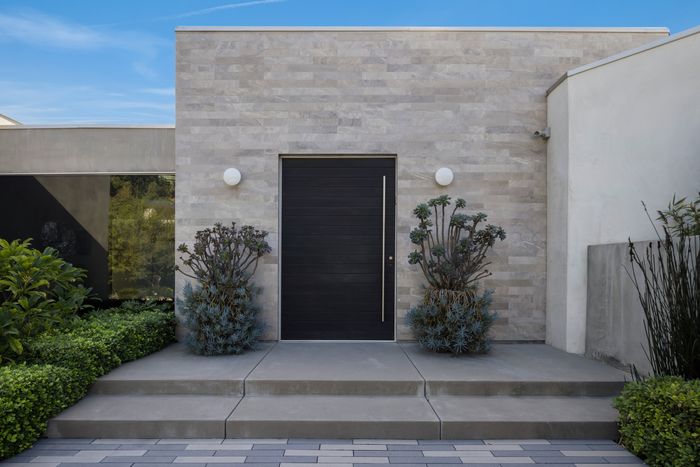
Mary, from Selling Sunset, walks through a door made for a giant.
Photo: Netflix
The people who own Erewhon have a house that looks like you might expect. There are leather walls, for example. A bathroom that’s all silver-wave marble and a travertine-clad kitchen with a fridge stocked with Hailey Bieber smoothies (sorry — smoothies with the “spirit of Hailey”). And yet its most astonishing feature is somehow the front door: almost comically large, two stories tall. “This is maybe the most insane door I’ve ever seen,” says Alanna, one of the Oppenheim Group brokers touring the house during the most recent season of Selling Sunset. She is dwarfed by the frame, which is more than double her height. It’s the first time in nine seasons any of the brokers have said something remotely relatable.
An oversize front door has long been a staple of luxury real estate in Greater Los Angeles, but the Erewhon door was in its own class — a door for a giant who lives at the top of a beanstalk. “Everybody, even if they liked the house or didn’t like the house — they loved that door,” Kevin Booker, the Carolwood Estates broker who handled the listing for the sellers, said. The house ultimately sold for $28.5 million — $6 million more than the owners had paid a year before. Was it the door? (Booker estimates it’s in the top-five biggest residential doors in the city.) The Erewhon door’s gigantism definitely places it on the far end of the bell curve, but it’s also not alone. Browse high-end listings in Sherman Oaks or the Hollywood Hills and you’ll start to notice a pattern: The big doors have gotten bigger.

A door for a listing that broker Brent Watson sold in Beverly Hills.
Photo: Christopher Amitrano

The “magnificent 20-foot door” featured in the listing for Michael B. Jordan’s house.
Photo: Chernov Team

A big door that is now a “normal”-size door in Los Angeles.
Photo: Lawrence Fitz Simons
The standard height for an off-the-shelf front door is six feet and eight inches — pitiful, really. An eight-bedroom, ten-and-a-half bath that Michael B. Jordan put on the market back in 2023 boasted “a magnificent 20 foot door.” Meanwhile, a six-bedroom in Encino currently going for $9.7 million has an 11-foot bleached-wood behemoth. (Even the pocket doors are “oversize,” per the listing.) Even when the exact size of the doors isn’t specified, they all look undeniably huge. Los Angeles used to be a place of many kinds of doors — double-doors on a Georgian mansion in Beverly Hills, a rustic little wood number in the Normandy-style homes of Montecito. But today’s ultramodern boxes with 20-foot ceilings have engendered a kind of Big Door Singularity. As Marc Noah, a Sotheby’s broker, put it, “If you had a double door in 2025, people would look at you funny, unless my mother or grandmother bought the house.”
A large door is a large feat of engineering. George Topalian, founder of West Coast Architectural, a luxury door and window manufacturer, says that a door that is 12 feet tall can weigh up to 1,500 pounds and still use standard hardware. Anything beyond that, though, requires custom hardware. Topalian has made doors up to 24 feet tall that require their own steel or aluminum substructure. “It’s a little ridiculous to have a door that tall, but we’re in the custom field,” says Topalian. “If they can afford it, we can build it.” The challenge is the weight, door-makers say: making sure that all that poundage is evenly distributed and that the door doesn’t end up leaning over time. “We take pivot doors that are 16 to 18 feet tall to shows, and people are like, ‘Wow that’s big,’” says John Barnes, the vice-president of sales and marketing at Panda Windows & Doors. “And we’re like, ‘It’s kind of small.’” His clients keep asking for bigger and bigger doors, he says. The biggest the manufacturer has made so far is 25 feet tall. Costs start around $25,000 but can run up to $100,000.
The logic here is obvious, even if the scale seems out of hand: The front door is the first thing anyone sees, and having a gigantic one sets a certain tone. Brent Watson, a broker with Beverly Hills Estates who has also noticed the big-door embiggening, agrees: “I think your entrance is always your first point of reference,” he says. At this price point, if a client doesn’t immediately like the look of the house, it’s basically a “nonstarter.” Another reason the doors are getting larger? “People with big egos want to have a big presence,” he tells me.
I asked brokers whether the people who buy these big-door houses actually use them. (It’s kind of preposterous to imagine heaving open a 20-foot-door every time you want to get the mail.) Some of them claimed that they do. “It was used all the time,” Booker said of the Erewhon door. “It was very easy to open.” Watson of Beverly Hills Estates, though, acknowledged that big front doors are often for show — a formal entrance for when you aim to impress. As for coming in from a morning at Tracy Anderson? “They’ve got their mud-room entrance, too.”
Sign Up for the Curbed Newsletter
A daily mix of stories about cities, city life, and our always evolving neighborhoods and skylines.
Vox Media, LLC Terms and Privacy Notice
Related

